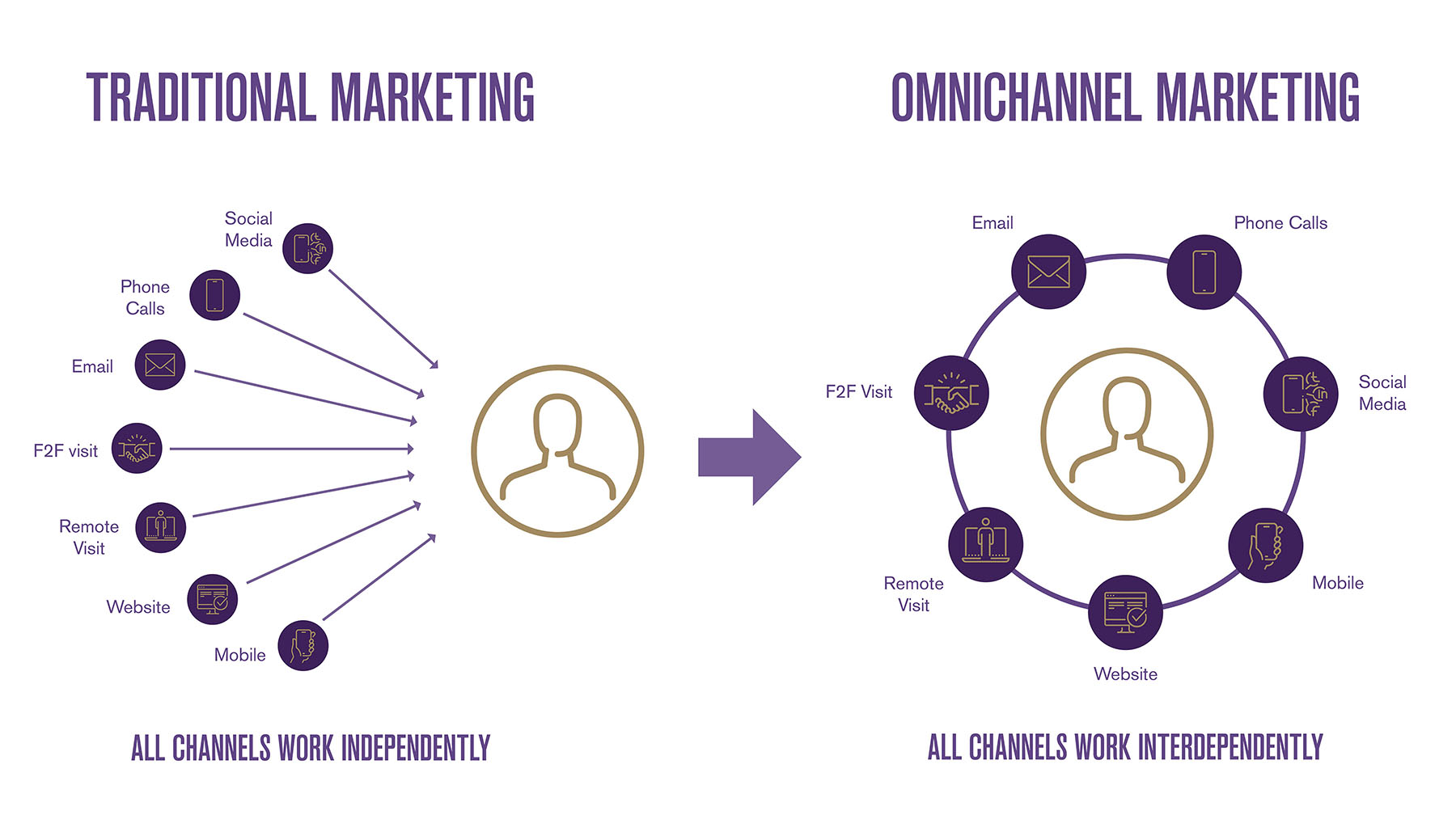For 2023, omnichannel architecture has continued to be top of mind for pharma marketers. Taking advantage of the available MarTech tools remains key to a successful marketing strategy. When building an omnichannel architecture, pharma marketers should ensure eight tech components are integrated to achieve their goals of reaching their desired audiences, delivering clear messaging that invoke actions, and achieving success in terms of sales, outcomes for patients, and expanding the footprint of the company and its products.
1. Patient Journey Mapping and Next Best Action
It all begins with mapping the various journeys that the desired audiences want or need. Today’s modern MarTech platforms need to be able to provide content and communications where the audiences are. Social media, where the highly sought after Gen Z audiences turn for news and information, is one example.
Understanding how a campaign might jump from one channel to another is key, and how the campaign’s content must shift as the channel changes is another consideration. For example, a consumer might see the first post in a campaign on Facebook, then be shown the next message in the campaign on Instagram, and another on LinkedIn or TikTok. A brand can deliver a holistic message across channels instead of having to deliver all points at once.
 Creating a customer journey isn’t new; how it is delivered is. Back in the 1950s, a company called Burma Shave advertised by placing road posts along highways. Each post was structured so that you needed to continue on the highway to see the message in its entirety. The result was that people would drive further to get the full message, and a sense of excitement and anticipation built as drivers wanted to get to the end and see the entire ad.1 In many ways, this was the precursor to banner ads and set a foundational component of omnichannel marketing—create a journey.
Creating a customer journey isn’t new; how it is delivered is. Back in the 1950s, a company called Burma Shave advertised by placing road posts along highways. Each post was structured so that you needed to continue on the highway to see the message in its entirety. The result was that people would drive further to get the full message, and a sense of excitement and anticipation built as drivers wanted to get to the end and see the entire ad.1 In many ways, this was the precursor to banner ads and set a foundational component of omnichannel marketing—create a journey.
With a solid journey, marketers can design their campaign to achieve the next best action from their customers. Simply put, the next best action presents the customer with the least amount of friction to purchase or act upon the message.
Examples of next best actions in marketing might include sending a targeted email with a personalized offer, suggesting a product or service based on the customer’s browsing behavior, or recommending a follow-up action based on the customer’s previous purchase history. The goals are to improve the customer experience and increase the likelihood of conversion or retention, while also maximizing the ROI of marketing activities.
2. Digital Asset Management (DAM)
Digital asset management is another “must-have” in today’s marketing toolbox. What is a digital asset? A video, photo, document—virtually any file that is stored digitally. Digital assets can be distributed to multiple platforms and allows marketers to maintain version control, size and scaling, expiry, and other metadata so that the assets can be analyzed as they appear. For example, if there is a label update to a drug, all images of the drug should be updated, and the best way to ensure a global update is to leverage a central repository. The DAM would not only keep versioning of the digital assets central; it would also ensure propagation and distribution is integrated.
3. Customer Relationship Management (CRM)
The ability to progressively profile customers is a key component of omnichannel marketing. Tracking not only where a customer is, but what they are consuming, when they are consuming, and any conversations or actions around said consumption is paramount to gaining the 360-degree view of a customer. Learning from these interactions and dynamically adjusting content and segmenting similar users into dynamic categories is critical. Brands can use platform tools such as Salesforce, HubSpot, and Veeva which provide CRM functionality natively, and customize them to their specific business requirements.
4. Marketing Automation
Many companies have implemented email tools such as Mailchimp, Salesforce Marketing Cloud, Marketo, etc. These can be stand-alone systems to send and track emails, however, the true power comes from integration with the content management system (CMS) and CRM to help progressively profile and lead to the next best action. Understanding how to build email journeys and branching based on varied responses can help a marketing professional understand content behaviors and allows for dynamic modeling of content based on when an email is opened or acted upon.
5. Customer Data Platforms (CDP)
Combining all this MarTech data into a unified system, or at least integrating multiple data streams from key systems, will help marketing teams establish their customer data platform. The CDP is essential for understanding the actions of a customer and developing that “360-degree view” of their behaviors.
Unlike a traditional CRM, a CDP will leverage all data sources, both known and unknown, or structured and unstructured. It also provides for extensive data cleanup capabilities, so that a brand can ensure that all actions are attributed to the correct customer.
CDPs are also the backbone of many analytics and measurement tools, although many come with strong capabilities out of the box. The biggest names in this space include Salesforce, Adobe, and Tealium.
6. Social Media
Following the “go where the customers are” approach, most marketers are spending time managing their various social media channels, but many just post the same content across various channels which is detrimental. Instead, marketers should leverage the power of omnichannel to dynamically change the content based upon the “voice” they want to project on each channel.
For example, a major retailer posted about a “Buy One, Get One Free” on their Facebook feed, and then over on Instagram they highlighted curated quotes from customers who took advantage of this offer. The result was a broader campaign and improved approach.
Tools such as Sprinklr, Meltwater, and Facebook Insights can help inform the CRM and CMS so the content not only changes, but adds to the progressive profiling about each customer, their behavior, and interaction. All this leads to great predictive analytics.
7. Media and Search
One of the most important aspects of any marketing strategy is effectiveness in media and search. Not only understanding the appropriate channels to target, but also ensuring that the data provided in the analytics and measurement reports is being leveraged.
Look for solutions that provide channel-specific integrations, personalization capabilities based upon channel, and the ability to create and receive triggers from other channels that influence the next best action.
Since media is typically a large part of the marketing budget, selecting the right platform to maximize media capabilities is traditionally the first place many marketing teams start. This is not a bad approach, but always consider the long-term MarTech strategy and goals when selecting a platform.
8. Data Analytics
One item often deprioritized at the onset of developing an enterprise MarTech stack is the strategic design and development of a robust and scalable data analytics capability. We’ve often seen clients try to “bolt this on” later, after they’ve selected several other platforms in their ecosystem.
Although it’s still possible to develop strong marketing operations analytics this way, it’s certainly more time consuming and costly than making sure it’s considered from the onset of capability planning. Many of the larger CDP/CRM solutions will have “onboard” analytics capabilities, but need to be extended to develop real insights outside of their core data boundaries.
Over the last several years, data analytics has become quite the buzzword for marketers as they lean in to truly understand the impact of their programs. Of course, all the big players are here; Salesforce Tableau, Google Looker Studio, Twilio Segment, Qlik, and more. Or more focused cloud-based data analytics companies, such as Domo or Supermetrics, might fit the need as well. The more complex solutions include stronger capabilities around predictive modeling and lean towards using machine learning and predictive models to deliver better next best action for potential customers.
In the 20th century, advertising agencies used market research, focus groups, and surveys to determine customer behaviors. In the 21st century, we are able to leverage the ubiquitous connections that exist between various systems to dynamically change content, messaging, and call to actions in near real time.
No matter the size of your brand or organization, you should always consider an enterprise-level ecosystem. Don’t over-develop one area and neglect others. Periodically perform a maturity assessment across the MarTech stack to ensure that platform potential and investment is optimized. By doing so, your marketing efforts will be prepared for 2023 and beyond.
Reference:
1. Rowsome Jr., Frank. “Verse by the Side of the Road: The Story of the Burma-Shave Signs and Jingles.” Plume. Reissue edition published September 1, 1979. https://www.amazon.com/Verse-Side-Road-Burma-Shave-Jingles/dp/0452267625.











